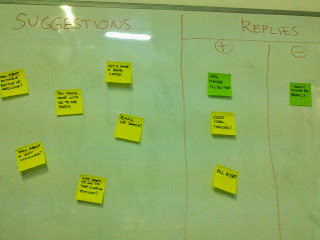Learning is a treasure. So why don't we review or introduce a new topic with a treasure hunt?
 A treasure hunt is an excellent way to make your students:
A treasure hunt is an excellent way to make your students:- work together,
- teach each other,
- feel motivated,
- practice listening and speaking skills.
Here you are two examples of my personal experience:
Case 1
I used a Treasure Hunt at the end of a course in order to review the grammar and the vocabulary we studied. The hint cards were divided in two parts. As you can see, at the top there are questions and at the bottom there are hints to find the next question.
Case 2
Last October 4th I started a new course with 6 adult intermediate students. In order to introduce three different general topics
1. Pronunciation (minimal pairs, tongue twisters, homophones)
2. Spelling
3. British English vs American English
we were going to deal with during the course I used this treasure hunt*.This time there was not any material treasure but a special sentence students had to find out by taking a letter from each hint. I was impressed because working in pairs allowed all of them to succeed in finding the treasure.
What is the sentence? Why don't you try to find the treasure? Write a comment with the sentence and I'll let you know if you are right!
*Tips for teachers: (The activity lasts 60-65 minutes/ every round takes 4 minutes)
1. Cut out the cards.
2. In pairs Ss get a card and they have 4 minutes to write the hint on a paper.
3. T monitors and interacts with Ss when there are LISTENING cards.
4. At the end of the 4 minutes T tells the pairs if they can get another card or keep sorting out the previous one.
5. When Ss have all the hints, they try to find out the treasured sentence in 4 minutes.










